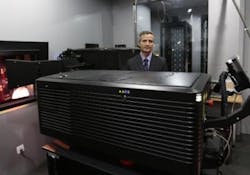Christie unveils first commercial pure-laser projection system, shows 23-meter-wide Godzilla
Christie Digital Systems USA has unveiled what it calls the world's first commercial pure-laser projection system; Christie showed the system on June 13, 2014 at the Shanghai Film Art Center, the first cineplex built in China. The cineplex has 23-meter-wide screens.
The featured movie was "Godzilla."
During the past two years, Christie has demonstrated high powered laser projection systems at numerous industry events.
Christie laser projectors will provide a brightness of up to 72,000 lumens per projector head, wider color gamut capabilities, higher contrast, and much-reduced maintenance requirements, according to the company. Christie's own conventional xenon-lamp projector technology produces 34,000 lumens.
Christie's laser-projection system has a scalable and upgradable architecture, which allows users to select the amount of laser light needed for their screen, with the capability to simply add more laser modules in the future if they wish to increase the brightness. Using the Christie Duo system, there is no practical limit (says the company) to the amount of light that can be put on a cinema screen.
If the mechanical cooling components in one module experience a failure, then only that module goes dark, but the movie can still play very brightly with the light from other modules. In contrast, competitive architectures have a higher-risk single cooling unit.
Christie is owned by Ushio (Tokyo, Japan).

John Wallace | Senior Technical Editor (1998-2022)
John Wallace was with Laser Focus World for nearly 25 years, retiring in late June 2022. He obtained a bachelor's degree in mechanical engineering and physics at Rutgers University and a master's in optical engineering at the University of Rochester. Before becoming an editor, John worked as an engineer at RCA, Exxon, Eastman Kodak, and GCA Corporation.
